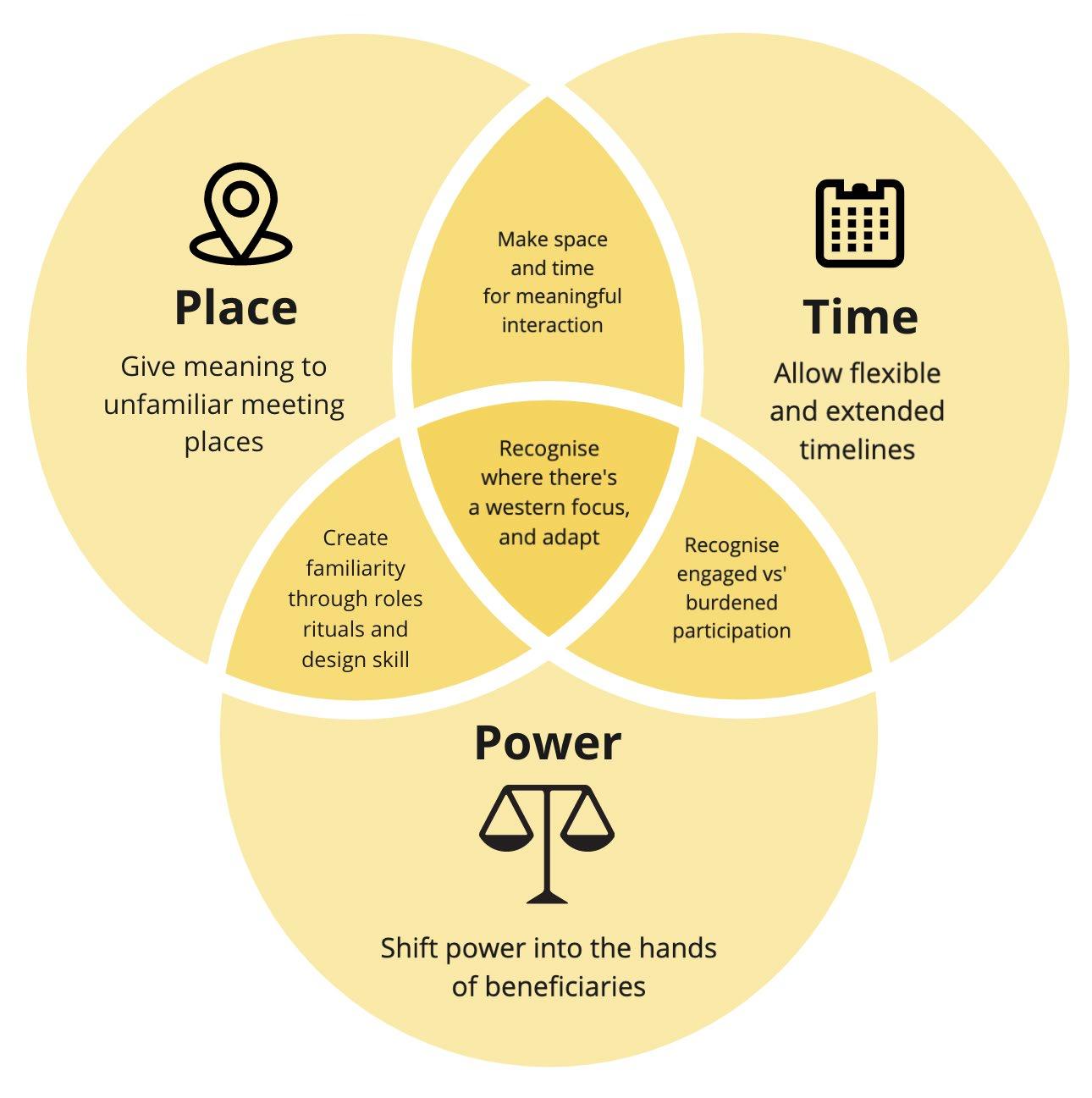Key findings
Social Innovation processes commonly reflect dominant, Western approaches to problem solving and aren’t always inclusive of diverse cultures and communities who might approach challenges differently. This research explored how a Canadian social innovation lab, the Alberta Bhutanese Employment Lab, in Edmonton, adapted its work to support interactions with the Bhutanese refugee community. The study showed how the lab could better serve beneficiaries through co design. Three aspects of the lab’s work were adapted to improve sensitivity to cultural dynamics and better involve the community in the innovation process:
• ‘Place work’, which gave meaning to unfamiliar meeting spaces;
• ‘Power work’, which shifted power to the beneficiaries;
• ‘Temporal work’, which adapted design processes to allow flexible timelines.
Combining these approaches meant identifying where ethical tensions and risks existed in the innovation process and how to better engage beneficiaries on their own terms by undertaking a culturally adapted social innovation approach. This included shifting leadership power into the hands of beneficiaries, recognising when participants felt engaged or burdened, and creating familiarity through roles, rituals, design craft and allowing time for meaningful interaction.

1
Doing culturally inclusive co design in social innovation labs
In theory, social innovation labs can enable diverse people to collaboratively design solutions to profound challenges. Including marginalised people is critical because they are disproportionately affected by the social challenges and systemic injustices these labs seek to impact. In practice, this is difficult because of cultural differences, coupled with deeply embedded patterns of exclusion
The premise of this research is that innovation labs are not inherently inclusive. This builds on the work of Westley et al. (2017) who assert that inclusion of diverse groups in social innovation labs often requires radical shifts in Western oriented processes
The case study followed a two year social innovation project called ‘Design by Doing 2.0 Bhutanese Employment Lab’, conducted between 2018 and 2019 by the Bhutanese community in Edmonton and several community focused organizations. The lab aimed to help members of this community secure local employment.
The people who participated have experienced complex socio economic challenges since their resettlement in Edmonton between 2009 2015. For nearly two decades prior, they lived in UNHCR run refugee camps in Nepal, after more than 100 thousand ethnic Lhotshampas people Bhutanese people of Nepalese descent were expelled by Bhutan and stripped of their citizenship In the camps, they received interrupted formal education leading to low literacy rates. They also experienced conditions of malnourishment, controlled movement, limitations to engaging in work, and minimal access to legal support. This resulted in identity loss and marginalisation (Banki 2008).
Over forty people participated in the lab, building three prototypes: Supplemental English Language Learning for Employment; Supported Micro Enterprise; and (the most impactful prototype) Community Led Employment Brokering.
The study identified how this lab achieved more inclusive co design by adapting its approaches to place, power and time
Emerging themes
Place and Power
“The most fundamentally critical component to the lab is the feeling that [the Lhotshampas people] hosted us, so that they told us who they were... That was critical to them feeling comfortable and everybody taking the time to get to know each other and feel safe with each other”. (Lab funder)
During the lab planning phase,two Bhutanese leaders visited the downtown open concept design studio selectedfor the lab. They deemed it would be overwhelming for Bhutanese participants if left unchanged. Lab conveners had to acknowledge that the space selected was not neutral from the beneficiary’s perspective
To address this, community members decorated the studio with traditional fabrics, scrolls and other cultural artefacts such as dolls and pictures. The meeting also included traditional music, rituals, food and storytelling This place making activity not only made the participants feel more at home, it also shifted the power balance so that the Bhutanese were felt to be hosting the lab.
Building familiarity in this way also helped lab convenors to continue to advocate for the Bhutanese, ensuring their perspectives remained central to the entire lab process.
2 Background
Place and time
“We achieved quite a bit in a short period of time in the two lab days, but of course, time is always a tension. Professionals don't have all that time to be able to provide, and time is just precious, right? It’s something we were really grappling with.” (Lab Convener)
From the Bhutanese perspective, two days was too short for the in person lab. The first day strove to ground all participants in the ‘unique context, realities, cultural values and experiences of the Bhutanese community while the second day focused on collectively prototyping solutions. Upon reflection, the Bhutanese and lab organizers described these two days as ‘woefully inadequate’ for proper solutioning Bhutanese facilitators felt that ‘direct translation without time to discuss and make meaning is not true inclusion’. Lab activities seemed ‘all too rushed’ and ‘each component could have been two, three, or four times as long’. However, the non Bhutanese participants felt that committing two days was already a 'big time commitment' (Action Lab, 2019), and some stakeholders left when the process took longer than expected.
Some Bhutanese participants responded negatively to others leaving early because they felt their contribution would be valuable. The lab’s core team remained flexible with their deadlines, adding two evenings to complete the prototyping process. Extended discussions were vital, and flexibility was seen as critical to inclusion.
After building relationships with the Bhutanese community, lab members gained a deeper appreciation of their extreme circumstances and felt responsible for providing tangible outcomes. The endpoint of the partnership became blurred as additional workshops were scheduled to co design prototypes that could be piloted. Reflecting on this, participants recommended that, in future projects, rather than allocating Bhutanese participation to a discrete phase of in person lab workshops, they could be spread across the duration of the partnership, which includes pre lab planning, and post lab audit components. This would enable leadership teams to be more responsive to beneficiary perspectives
Time and power
Time constraints also heightened tensions related to power dynamics between Westerners and the Bhutanese. For example, one western participant could not stay at the lab past 4:30 pm during a storyboarding exercise. She rushed the activity, overlooking contribution from the Bhutanese in her group. Such time constraints resulted in a sense of burdened participation, which led western participants to proritise outputs over the full integration of Bhutanese perspectives.
To address this, a process of ‘continual reflection’ was undertaken (Action Lab, 2019). The aim was to keep one another accountable to the principle of valuing the knowledge of those with lived experience. Although this required additional time, it resulted in ‘powerful learning’ among stewardship members. It provided a caveat for them to get ‘yanked out of [their] Western productivity perspective’ to collaborate more intentionally.
The stewardship team recognised that the Bhutanese also had outside responsibilities, and often engaged in ‘invisible labour’ (Action Lab, 2019), meaning informal unpaid work. It was important to acknowledge the time they devoted to the lab (Action Lab, 2018). For this reason, community lab participants were paid for their time, all travel related costs were covered, and the two Bhutanese leaders were further compensated for their involvement with the stewardship team.
3
Balancing power, place and temporal work for inclusivity
By reconsidering place and time, it is possible to shift power into the hands of beneficiaries. It is essential to consider how power and privilege can impact a teams’ ability to relate to the participants they are working with. It may be necessary to recalibrate the expectations of ‘productivity focused’ Western participants. Power dynamics are also reflected in the places used for social innovation work, which can feel imposing. ‘Place making’ can help to overcome this, particularly when led by representatives of the marginalised community. Extending standard lab timelines can also allow room for relationship building, leading to more authentic co design.
Implications and future research
This research presents practical insights for social innovation practitioners who wish to adapt innovation processes to be more aware of unequal power dynamics. These insights support literature on inclusive innovation, which aims to develop and implement tools that provide more capacity and wellbeing among disenfranchised members of society (George et al., 2012).
The insights offered here are based on the specific case of a Bhutanese refugee community engaging with a social innovation lab in urban Alberta. While this case highlights some ways social innovation practitioners can adapt, it would be valuable to compare further examples of how labs have worked with marginalised communities in other parts of the world.
In this case, the collaboration was strengthened by the close knit ties of the refugee community, which were present before the lab. Engaging less cohesive groups would likely present further challenges.
In addition, we can observe that for social innovation labs situated in poor regions, it is often the lab conveners or facilitators who are outsiders, either culturally or socio economically, rather than the participants. Further research observing the power dynamics of those labs could help to ensure practitioners’ critical self awareness and cultural sensitivity.
References
Action Lab (2019) Design by Doing 2.0 pathways to employment. Internal report. Unpublished. Action Lab (2018) Design by Doing project: Focus group evaluation. Internal report. Unpublished. George, G., McGahan, A. and Prabhu, J. (2012) ‘Innovation for inclusive growth: Towards a theoretical framework and a research agenda’, Journal of management studies, 49(4), pp.661 683. Westley, F., Goebey, S. and Robinson, K. (2017) ‘Change lab/design lab for social innovation’, Annual Review of Policy Design, 5(1), pp.1 20.
About the project
This report was published in 2022 and based on research conducted between 2018 and 2019 in Edmunton, Canada. It is based on the analysis of 11 interviews, field notes and consultation of internal DBD 2.0 reports such as the lab’s developmental evaluation, post lab focus groups and additional images and materials used within the lab.
This research was carried out with the support of The Cambridge Centre for Social Innovation, Edmonton’s Bhutanese Community, EndPovertyEdmonton and the Skills Society Action Lab. It was designed and conducted as part of the MSt Social Innovation, with the support of faculty and fellows of the programme.
4
The Centre is committed to ensuring wide access to our research findings. We welcome your feedback and ongoing support. The views of the authors do not represent those of their employers or CJBS. If you wish to discuss this research or access the full report, please contact the Centre at: socialinnovation@jbs.cam.ac.uk
The Cambridge Centre for Social Innovation builds best practices across business, civil society, policy and academia for a more equitable, inclusive and sustainable world.
5








Cambridge Centre for Social Innovation Cambridge Judge Business School University of Cambridge Trumpington Street Cambridge CB2 1AG United Kingdom T +44(0)1223 339700 socialinnovation@jbs.cam.ac.uk www.jbs.cam.ac.uk/centreforsocialinnovation









